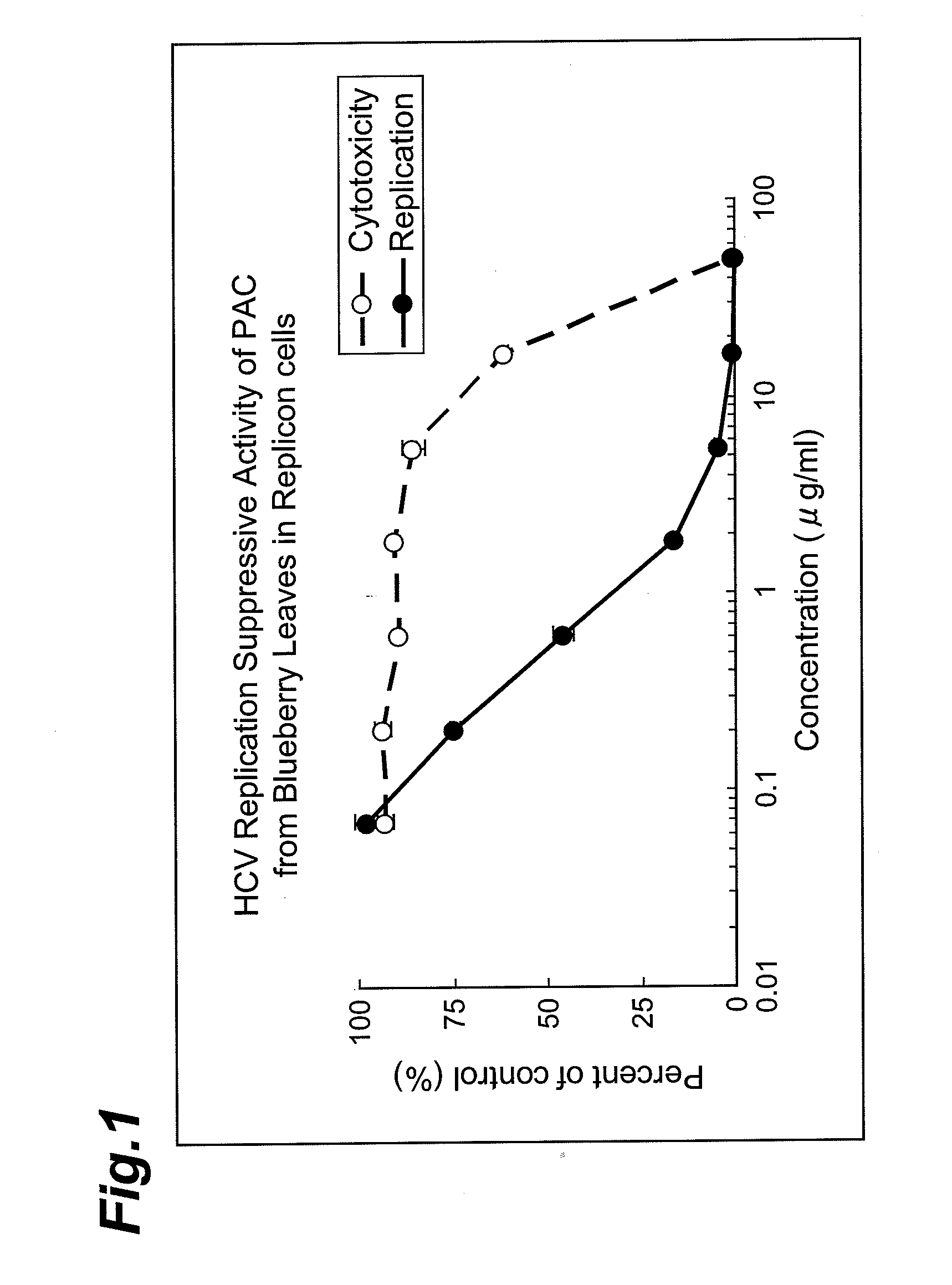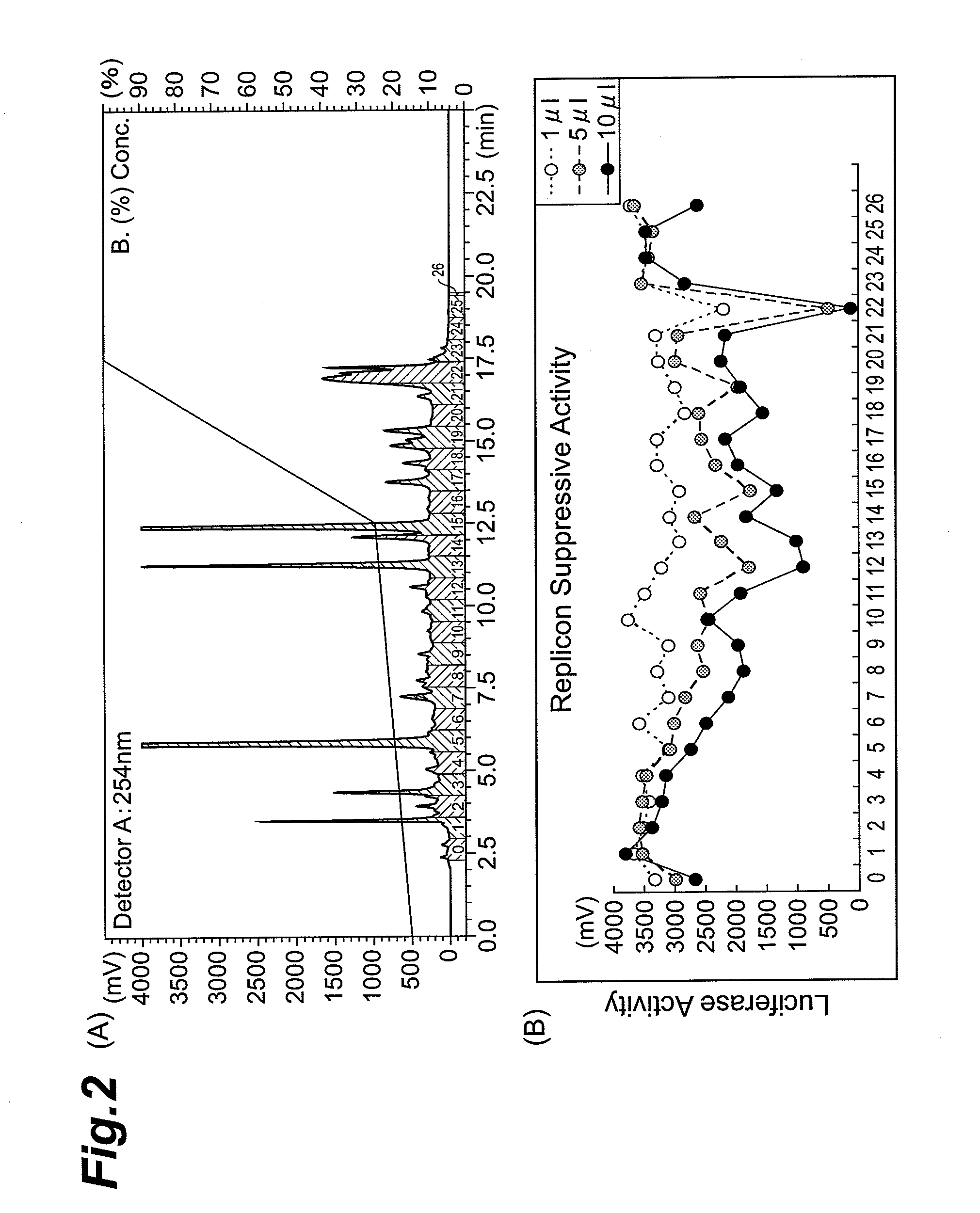Agent for inhibiting production of hepatitis c virus and its use
a technology for hepatitis c virus and agents, which is applied in the direction of synthetic polymeric active ingredients, drug compositions, plant/algae/fungi/lichens ingredients, etc., can solve the problem of unclear effective chemical substances in blueberry leaf, and achieve significant anti-hcv activity, fewer side effects, and long dosing period.
- Summary
- Abstract
- Description
- Claims
- Application Information
AI Technical Summary
Benefits of technology
Problems solved by technology
Method used
Image
Examples
example 1
Identification of Effective Compounds for Suppressing HCV Replication Contained in the Blueberry Leaves
[0125]1. Extraction and Liquid-Liquid Distribution
[0126]One gram of the lyophilized powder, which made from the leaves of rabbit-eye blueberry (Vaccinium virgatum Aiton), was extracted with 100 ml of methanol at room temperature under shaking for 15 min, and the supernatant of the resultant extract was passed through filter paper (Toyo filter paper No. 2). The methanol extract was further extracted with 100 ml of chloroform, followed by the resultant precipitate and supernatant were collected. The precipitate was dissolved in methanol, concentrated in vacuo and lyophilized (CMW-ppt: 63.7 mg). The supernatant was mixed with 150 ml of distilled water and methanol to perform a liquid-liquid extraction, and the water layer was collected and mixed with 150 ml of chloroform so as to repeat the chloroform extraction. The water layer was concentrated and lyophilized (CMW-W: 284.2 mg). The ...
example 2
Extraction of PAC Contained in Some of Material and Replication Suppressive Activities
[0226]1. PAC Preparation from Various Materials
[0227]From results of example 1, the proanthocyanidin (PAC) was identified as compound possessing the suppression activity of HCV replication. PAC is previously known as condensed tannin and contained in various plants and foods. It has been already reported that the following materials contain PAC, so, PAC fraction can be separated from these materials.
[0228]Sample 1; blueberry leaves
[0229]Sample 2; blueberry fruit
[0230]Sample 3; taro peel
[0231]Sample 4; pine bark extract (Pycnogenol™)
[0232]Sample 5; grape seed extract (Gravinol™)
[0233]Sample 6; apple polyphenol (Applephenol™)
[0234]Sample 7; cranberry (cranberry powder)
[0235]Sample 8; strawberry fruit
[0236]Sample 9; peanut peel
[0237]Sample 10; croton sap (Sangre de Drago, Raintree Nutrition Inc.)
[0238](Separation of PAC Fraction from Blueberry Leaves: Sample 1)
[0239]10 g of the lyophilized powder of r...
example 3
The Bulk Preparation of PAC from Blueberry Leaves
[0251]To prepare PAC from blueberry leaves, freeze-dried powder (105 g) was extracted with 1.2 liters of acetone for 10 min and the supernatant obtained was then decanted. This procedure was repeated five times to remove the green pigment from the leaves, followed by washing in 1.2 liters of hexane for 10 min. The remaining residues were washed with ethyl acetate. The washed powder of leaves was further extracted with 1.2 liters of methanol for 30 min, and the supernatant obtained was then filtered. This procedure was repeated four times and the resulting crude methanol extracts were concentrated by rotary evaporator at 50° C. and lyophilized, finally resulting in approximately 30 g of solid powder.
[0252]The crude methanol extract (15 g) was then dissolved in 1.0 liters of 60% methanol and placed on a Sephadex LH-20 column (50 mm×920 mm; GE Healthcare). Fractionation was performed using the following series of solvents: fraction I, 9....
PUM
 Login to View More
Login to View More Abstract
Description
Claims
Application Information
 Login to View More
Login to View More - R&D
- Intellectual Property
- Life Sciences
- Materials
- Tech Scout
- Unparalleled Data Quality
- Higher Quality Content
- 60% Fewer Hallucinations
Browse by: Latest US Patents, China's latest patents, Technical Efficacy Thesaurus, Application Domain, Technology Topic, Popular Technical Reports.
© 2025 PatSnap. All rights reserved.Legal|Privacy policy|Modern Slavery Act Transparency Statement|Sitemap|About US| Contact US: help@patsnap.com



